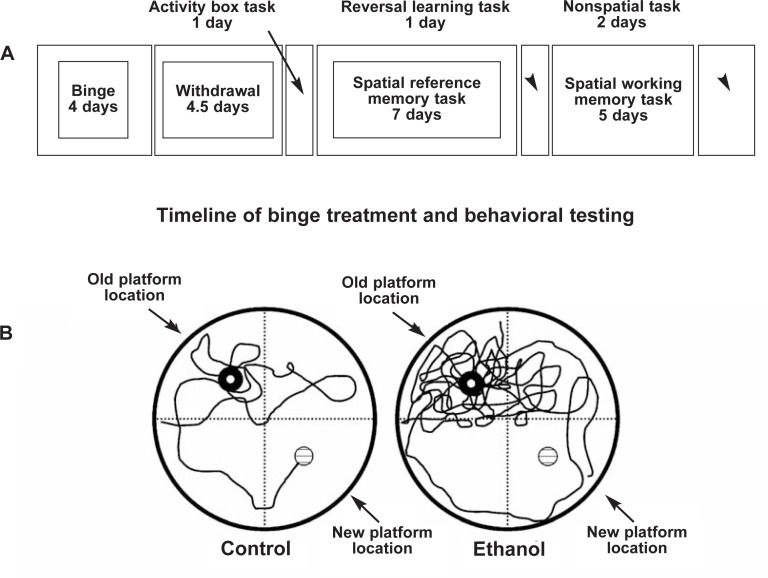Figure 3.
Alcohol-induced persevering, compulsive relearning deficits mimic alcoholic cognitive dysfunction. Shown are the time lines of treatment and testing (upper box) as well as the behavior of two individual rats (bottom two circles), a control (left) and a binge alcohol–treated (right) rat. As indicated in the upper box time line, the 4-day binge alcohol treatment was followed by a 4.5-day abstinent withdrawal period. This model induces physical dependence that can include seizures during withdrawal. Physical withdrawal symptoms subside within 24 hours in this model. It was reasoned that long-term, perhaps permanent, changes in behavior attributed to binge-induced brain damage would be apparent in abstinence beyond withdrawal. After 5 days of abstinence, special reference memory tasks were tested for 1 week using the Morris water maze. The Morris water maze involves learning the location of a hidden platform just under the water using visual cues on the walls surrounding a round water tank 6 feet in diameter. Both control and binge alcohol–treated animals could swim equally well, had normal activity, and easily learned to find the platform. Learning (decreased time to find the platform) with repeated trials was not altered. There was no indication of a persistent binge alcohol treatment effect on learning. However, when relearning tasks were tested at almost 2 weeks of abstinence, a persistent cognitive change was found. Both control and abstinent binge-treated rats readily learned the old platform location. However, reversal learning was disrupted in binge-treated rats. Reversal learning was tested by moving the submerged platform from the original position in the water tank to a position in the quadrant opposite that in which it had been placed during the learning memory task (moved from northeast to southwest quadrant). A vertical view of the tracks taken by control (left) and alcohol (right)-treated rats during the reversal learning task is traced in the two circles representing the water tank. Note the path of the control rat. It first investigates the old learned platform location, reflects on the platform not being in the old location, and then searches and finds the new platform location. Note the persevering of circling behavior shown by the binge-treated animal with numerous reentries into the original goal quadrant. The binge-treated rat failed to reach the new platform location within the maximum time allowed and was removed. Thus, the trace ends in the water and not on the platform. The loss of executive function in the binge alcohol–treated rat is apparent in the repeated, compulsive searching in the old learned position and the lack of cognitive flexibility to search the other areas.
SOURCE: Adapted from Obernier et al. 2002b.

